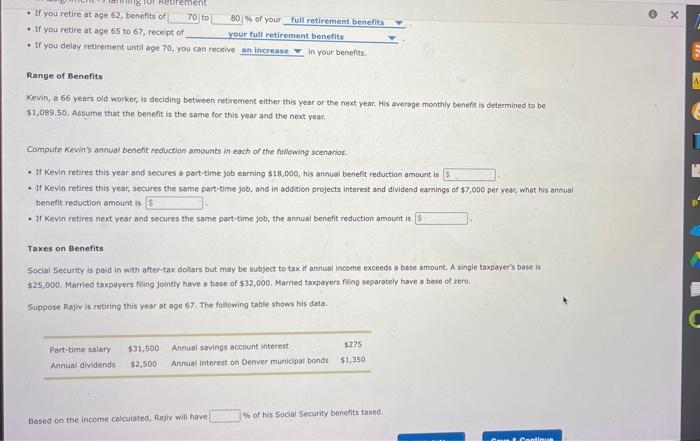If you retire at age 62, benefits of g for Retirement 70 to If you retire at age 65 to 67, receipt of 80% of your full retirement benefits your full retirement benefits If you delay retirement until age 70, you can receive an increase in your benefits. Range of Benefits Kevin, a 66 years old worker, is deciding between retirement either this year or the next year. His average monthly benefit is determined to be $1,089.50. Assume that the benefit is the same for this year and the next year. Compute Kevin's annual benefit reduction amounts in each of the following scenarios. If Kevin retires this year and secures a part-time job earning $18,000, his annual benefit reduction amount is If Kevin retires this year, secures the same part-time job, and in addition projects interest and dividend earnings of $7,000 per year, what his annual benefit reduction amount is $ . If Kevin retires next year and secures the same part-time job, the annual benefit reduction amount is $ Taxes on Benefits Social Security is paid in with after-tax dollars but may be subject to tax if annual income exceeds a base amount. A single taxpayer's base is $25,000. Married taxpayers filing jointly have a base of $32,000. Married taxpayers filing separately have a base of zero. Suppose Rajiv is retiring this year at age 67. The following table shows his data. Part-time salary $31,500 Annual savings account interest $275 $1,350 Annual dividends $2,500 Annual Interest on Denver municipal bonds % of his Social Security benefits taxed. Based on the income calculated, Rajiv will have 0 X C If you retire at age 62, benefits of g for Retirement 70 to If you retire at age 65 to 67, receipt of 80% of your full retirement benefits your full retirement benefits If you delay retirement until age 70, you can receive an increase in your benefits. Range of Benefits Kevin, a 66 years old worker, is deciding between retirement either this year or the next year. His average monthly benefit is determined to be $1,089.50. Assume that the benefit is the same for this year and the next year. Compute Kevin's annual benefit reduction amounts in each of the following scenarios. If Kevin retires this year and secures a part-time job earning $18,000, his annual benefit reduction amount is If Kevin retires this year, secures the same part-time job, and in addition projects interest and dividend earnings of $7,000 per year, what his annual benefit reduction amount is $ . If Kevin retires next year and secures the same part-time job, the annual benefit reduction amount is $ Taxes on Benefits Social Security is paid in with after-tax dollars but may be subject to tax if annual income exceeds a base amount. A single taxpayer's base is $25,000. Married taxpayers filing jointly have a base of $32,000. Married taxpayers filing separately have a base of zero. Suppose Rajiv is retiring this year at age 67. The following table shows his data. Part-time salary $31,500 Annual savings account interest $275 $1,350 Annual dividends $2,500 Annual Interest on Denver municipal bonds % of his Social Security benefits taxed. Based on the income calculated, Rajiv will have 0 X C







